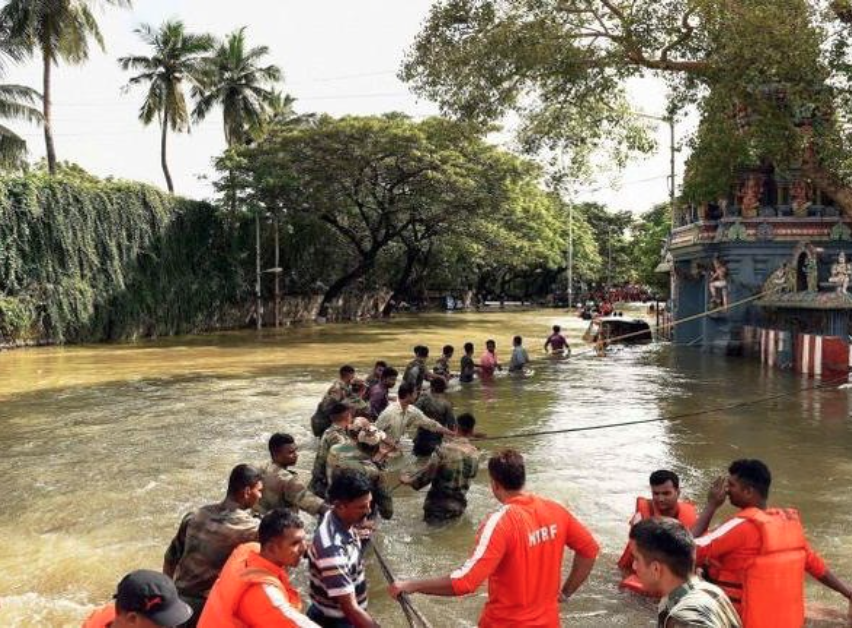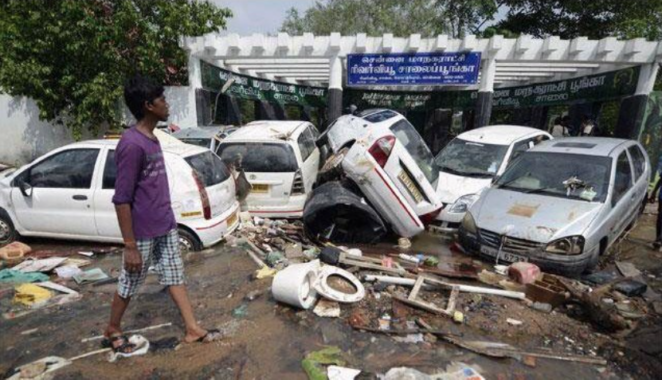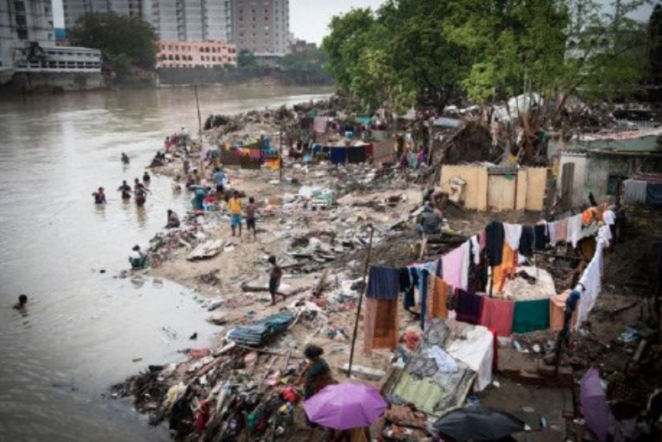Role of various sectors in demonstrating resilience during Chennai flood in 2015

Rationale of the study
Devastating floods washed over the city of Chennai in South India during November-December 2015. The floods claimed more than 470 lives and resulted in enormous economic damages of around US$3 billion. The city and its suburbs recorded several days of torrential rainfall between November to December 2015 which inundated the coastal districts of Chennai, Kancheepuram and Tiruvallur, and affected more than 4 million people (The National 2015).
In the MIOT International Hospital, 18 patients died as the hospital was located close to the Adyar River which overflowed its banks and damaged the power units supplying power to the ventilators used by patients (The Hindu 2015). Over 18 lakh (1.8 million) people were displaced because of the floods. About 30.42 lakh (3.042 million) families suffered total or partial damage to their dwellings; 3,82,768 lakh hectares of crops were lost including over 3.47 lakh hectares of agricultural crops and 35,471 hectares of horticultural crops. Roughly 98,000 livestock animals and poultry died (Narasimhan, Bhallamudi, Mondal, Ghosh & Majumdar 2016).
The huge impacts of the flooding brought together people and institutions in and around Chennai to provide support to the flood victims. Help arrived from different sections of society and in a variety of forms. These case studies provide an insight into the various actions undertaken by government departments, institutions, National Disaster Response Force (NDRF), civil defense, private enterprises, Community Based Organizations (CBOs) and social media during the floods. Understanding of their interventions and some of the challenges faced can help urban local bodies better prepare for such extreme events in the future.
Mainstreaming of some of the actions taken by the institutions can help cities improve their coping mechanisms and build climate resilience. Best practices can be derived to strengthen the existing risk handling capacities of the city as well as learn lessons and replicate similar initiatives for preparedness across some of the other Indian cities.
We expect these case studies will also help urban local bodies and other government agencies understand some of the challenges that are likely to emerge during urban flood disasters and use some of the learning to create coordination and collaboration mechanisms to ensure efficient rescue and response operations in future.
In the report
The case studies covered in this study document the actions of the following organisations/services:
- Emergency services:
- Fire Services
- National Disaster Response Force (NDRF)
- Police
- Relief and supplies from local entities:
- School
- Food supply
- Supermarket
- Service station
- Health and Transport Services:
- Health Services
- Transport
- Energy
- Social Networks:
- Community-Based Organisations (CBOs)
- Social Media
- Coping Mechanisms:
- Hospitality Industry
- Small and Medium Enterprises
For each organisation/service the situation, challenges, response, measures taken and suggestions and recommendation are provided.

Overview of the response to the flooding
The 2015 Chennai flood brought city life to a standstill. It affected the socio-economic condition of the city and its surroundings, resulted in deaths and damage to critical infrastructure, stranded animals and humans, disrupted services and made livelihoods and mobility difficult across most parts of the city.
Government authorities like the Fire Department, National Disaster Response Force (NDRF) and the Police Department were the first ones to be contacted in case of emergencies and showed their efficiency in dealing with such situations. Specially trained fire officials rescued patients, children, women, old people and pet animals, along with developing and enforcing evacuation plans. The Fire Dept.’s vehicles and pumps were used to drain out water from various water logged areas. This department received additional help from Chennai’s fishermen community in the form of mechanized boats to carry out rescue operations.
This was accompanied by humanitarian relief provided by the NDRF team. They conducted it in 2 phases, where Phase I was carried out in November and Phase II in December 2015. They supported other government departments in preparing evacuation plans and building teams for relief and rescue operations. Teams were divided and they carried out need based rescue, relief and rehabilitation activities within a periphery of 5-10 kms. In the meantime, the Police Dept. accommodated and relocated rescued people in police stations, schools and other government buildings located on safer grounds. In the post flood scenario, their main role was to reduce traffic and congestion.
Private enterprises such as restaurants, taxi service providers and automobile service centers, also joined hands with the government to provide relief to the flood affected population. Kolapasi, a Chennai based restaurant turned into a temporary food relief agency. Social media was used for awareness generation on the initiative and also to raise funds. Individuals of all age groups and across all professions, supported this initiative by volunteering to cook, wash utensils, pack and deliver food. About 1.7 lakhs food boxes were distributed across the city. Similarly, a vegetable and milk supplying chain, Heritage Fresh, sold their commodities at a subsidized rate when prices in parts of Chennai were on a rise. Mobile vegetable shops also put in efforts to reach out to as many flood affected people as possible. Online food service providers like Zomato, added one extra meal from the company’s side, per order that was placed for the stranded people.
Vehicle service stations like Harsha Toyota collected and repaired cars that broke down due to waterlogging. The company ordered its dealerships to take extra space for flood affected cars while insurance companies were asked to clear their claims on time. Commuting through the flooded city became a critical concern, particularly for conducting rescue operations and maintaining a continuous flow of supply chain for the affected population. Keeping this in mind, Ola started operating Ola boats which also provided an important learning for future preparedness measures. They strategically identified water routes for providing service to even the inaccessible areas. They also helped the Fire Dept. in conducting their rescue operations.
Community based organizations (CBOs) like Oxfam provided support through the provision of energy and fuel supply to households. Private companies like Servals Pvt Ltd. initiated a similar program of designing and provision of rehabilitation kit including kerosene stove, water filter, utensils, disinfectant, activated EM, composters, etc. to the slum dwellers, manual laborers and villagers in the worst hit areas. Other CBOs like Tamil Nadu Thowheed Jamath mobilized volunteers for carrying out rescue, relief, rehabilitation and reconstruction work, which included arranging food, shelter, cleaning up after flood water receded, waste management, spraying of insecticides and distribution of relief kit.
Social media such as Facebook, Twitter, Google Maps, etc. played an important role in bringing all the service providers and individuals to work together for reducing the impact and helping the flood affected population recover better. These platforms helped disseminate information, inform people of the undertaken initiatives, call for volunteers in respective sectors, crowdsource and map the waterlogged or inundated areas.
Small to medium sized enterprises (SMEs) suffered both physical loss as well as loss of their customer base. They demanded government to provide interest free loans and delay their tax payment along with other repayments. SMEs took adequate measures to build resilience against future floods through installation of electrical points at a raised height and flood defense barriers within their premises, and secured their databases using online recovery systems, etc. Amidst these complications, much needed help and support arrived from all directions and sections of society.

© November 2016
- Supported by: Asian Cities Climate Change Resilience Network
- Published by: Taru Leading Edge
- Authors: Jay Anand and Dr. Uma Ramachandran
- Edited by: Dr. Umamaheshwaran Rajasekar and Soumita Chakraborty
- Contributors: G. K. Bhat, Ajay Katuri and Binu Mathew
- Graphics and Design: Tejas Patel and Prashansa Dixit
Suggested Citation:
Anand, J. and Ramachandran, U. (2016) Role of various sectors in demonstrating resilience during Chennai flood 2015. Taru Leading Edge: New Delhi, India.
(0) Comments
There is no content